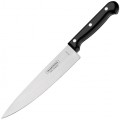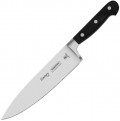Blade material
- Steel. In this case, we mean
steel blades made by stamping. It is believed that this method itself does not provide as high quality as forging; in addition, the blade and tang in this case can be made separately and then welded together, which further reduces the durability of the knife and increases the risk of breaking it under great force. However, stamped blades are easy to produce, inexpensive, and usually sufficiently durable for most tasks, both everyday and professional. This ensured their high popularity.
— Steel (
non-stick coating). Steel blades with a special polymer coating applied to them. It not only prevents the sticking of products, but also protects the blade from corrosion, makes it easy to clean, and also gives the tool an original and bright appearance - because the coating can be given any color. The tendency to abrasion reduces many of the advantages of such a blade to nothing.
—
Forged steel. Blades made of steel by forging. Such knives are considered much stronger and more durable than stamped ones, in particular because the shank and blade are initially one piece, which reduces the risk of breaking the knife. On the other hand, the process itself is quite expensive and troublesome, and therefore is used mainly in premium knives.
—
Damascus steel. In modern knives, Damascus steel
...refers to steel consisting of many layers with different carbon contents. Such layers vary in color, which gives the blade a characteristic beautiful pattern, while Damascus blades combine high strength, flexibility and durability. However, the complexity of production significantly affects the price - such knives can cost many times more than even similar forged ones.
— Three-layer steel. The name “laminated” is also found. As the name suggests, such blades consist of three layers of steel (this is one of the main differences from the multi-layer Damascus described above). These layers differ in composition and, accordingly, properties: the core is made of hard high-carbon steel, and the lining is made of soft “stainless steel”. This combination allows you to combine the advantages of both types: the core provides the blade with the necessary hardness, and the linings compensate for the fragility of high-carbon steel. Another advantage of three-ply blades is the ease of sharpening, since relatively little hard material has to be removed during the process. Their disadvantage is, first of all, their high price. In addition, the fragile core does not bear shock loads well, which is why such knives are unsuitable for chopping.
- Ceramics. Ceramic, usually zirconium based, is considered a very advanced material. It allows you to create very sharp blades that do not dull for a long time, do not oxidize, are easy to clean, are not susceptible to scratches, and also weigh much less than steel. On the other hand, ceramic blades are very fragile and have absolutely no flexibility, making them prone to chipping and very sensitive to shocks and falls. In addition, due to the high hardness of the material, such blades cannot be sharpened using traditional methods, and special ones are quite expensive - despite the fact that the cost of the knives themselves is also very high.
— Titan. Titanium-based alloys are premium materials. They are characterized by a solid appearance; titanium blades are also distinguished by their low weight combined with high strength properties. The blades of titanium knives do not enter into chemical reactions when in contact with food, which means they ensure proper hygiene in the food preparation process. Anodizing titanium allows you to get fantastically beautiful and rich colors of the blade. The main disadvantage, traditionally for such materials, is the high cost.Steel grade
The name of the steel grade from which the knife blade is made.
Its working properties directly depend on the type of steel — hardness, brittleness, tendency to corrosion, ability to keep sharpening, etc. Accordingly, this parameter largely determines the features of the knife as a whole. Many different grades of steel are used in modern kitchen knives; knowing the name of a particular brand, you can find detailed information about it (physical characteristics, reviews, user reviews) and evaluate the quality and overall level of the tool.
Plastic type
The type of plastic used in a knife handle.
See "Handle Material" for general features of this material. The specific types of plastic found in modern kitchen knives are very diverse in price and quality. In low-cost models, the following options are mainly used:
— ABS plastic. One of the most inexpensive varieties of plastic; relatively fragile and brittle material that does not tolerate heat, temperature extremes and exposure to the sun. However, with proper quality and careful handling, such a handle can last quite a long time.
— Polycarbonate. More advanced than ABS, and at the same time quite affordable kind of plastic. It is thanks to this combination of affordability and practicality that polycarbonate is popular in the market.
— Polypropylene. Polypropylene is notable primarily for its light weight and high hardness, making it highly resistant to abrasion and scratches. This material is sensitive to sunlight and oxygen, but these shortcomings are often compensated by the use of special additives. Also, polypropylene can be supplemented with elastomer — a soft and elastic material that makes the handle more pleasant to the touch.
— Bakelite. One of the first plastics in history that still has not lost its relevance. One of the interesting features of bakelite is heat resistance: even on an open fire, such material is charred, but does not melt or burn.
In turn, premium knives can be used, in particular, the followin...g types of plastics:
— G10. One of the varieties of fibreglass is glass fibre with a plastic filler. G10 is characterized by excellent strength and durability, this material perfectly tolerates moisture and temperature changes, and it is quite difficult to scratch it. Fibreglass weighs much more than carbon fibre; on the other hand, its price is much lower.
— Carbon fibre (carbon fibre, Carbon Fibre, etc.). Composite material in the form of carbon fibre threads filled with plastic filler. This combination provides low weight and at the same time extremely high strength — even relatively simple grades of carbon fibre are not inferior to steel in this respect. However and these handles are not cheap. In addition, this material is sensitive to specific loads, namely point impacts — this may cause cracks on it. However, for such a "trouble", most likely, a very unfortunate set of circumstances will be required.
— Mikarta. Composite material, a kind of textolite, consisting of layers of fibrous material filled with polymer. The composition of the base and the filler may be different, sometimes it is displayed directly in the title — for example, Canvas Micarta uses fabric as the base (canvas — canvas). At the same time, regardless of the varieties, the manufacturing technology of such a handle involves high-pressure sintering. Due to this, a very strong, reliable and durable material is obtained, insensitive to moisture, high temperatures and sunlight, pleasant in appearance and to the touch. With all this, micarta is inexpensive, it is suitable even for low-cost kitchen knives.
— Packawood. Material based on laminated wood combined with synthetic resins. For such handles, different types of wood can be used, which allows you to get different patterns on the surface; and the possibility of using coloring additives further expands the variety of design of such knives. Externally, such handles are indistinguishable from wooden ones, but they are much harder, stronger and more resistant to moisture.
Blade length
The length of a blade is usually measured from the point to the neck (the bulge between the blade and the handle). The value of this parameter is determined primarily by the type of knife. For example, in
models for cleaning, it rarely exceeds 12 cm — otherwise it would be inconvenient to work with small round products). Among
bread, on the contrary, blades shorter than 20 cm are rarely found — loaves of bread can be quite thick, which requires an appropriate knife, etc. However, knives of the same type can also vary significantly in length. In most cases, you can use this principle: a longer knife allows you to work with larger pieces of food, but it is less “agile”, and the length of the blade can affect the price.
Blade thickness
The thickness of the knife blade at its thickest point (usually at the butt). According to this parameter, one can to some extent evaluate the strength of the blade for transverse loads: a large thickness gives an appropriate margin of safety. At the same time, one should not forget that the “endurance” of a knife as a whole depends on many other features of its design, and only blades made of materials similar in properties can be compared in thickness. But what this indicator directly affects is the weight of the product.
Hardness
The hardness of the metal used in the knife blade. Indicated in standard HRC units (according to Rockwell); the higher the value, the harder the blade.
This parameter in knives has a double meaning. On the one hand, the blade must be hard enough so as not to dull prematurely, not form burrs and not deform when bent; on the other hand, it must remain soft in order to sharpen normally, not crack or break (brittleness also increases with increasing hardness). In most kitchen knives, the hardness is in the range of 52 - 62 HRC - it is believed that this range provides the optimal ratio of strength, reliability and ease of sharpening.
In general, ceteris paribus, a knife made of softer steel will have to be sharpened or adjusted more often with musat, however, such procedures themselves will take a little time and effort. Conversely, a hard blade will hold sharpening for a long time, however, you will have to try to restore it.

